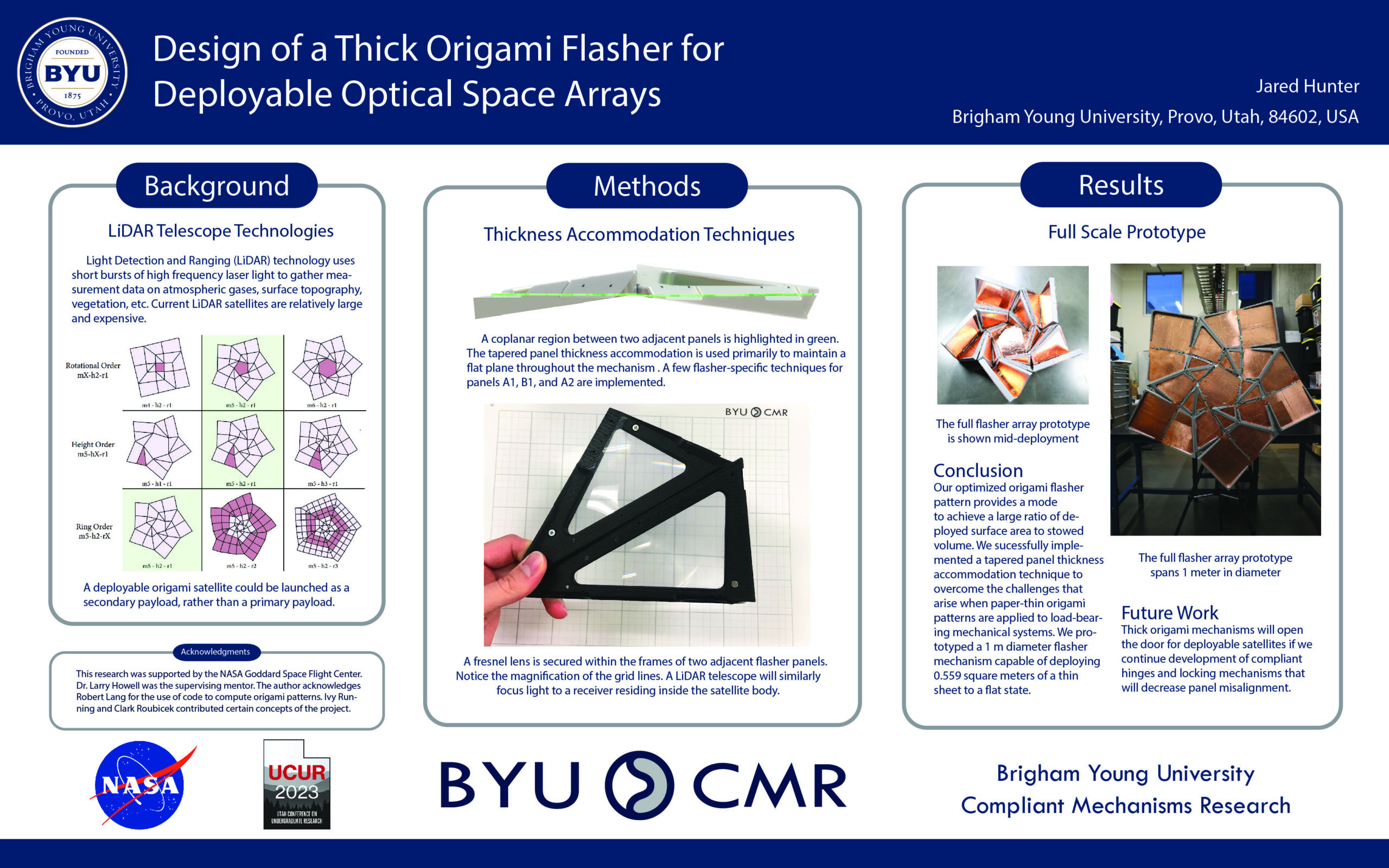Presenter Name: Jared Hunter
Description
Purpose
LiDAR telescopes serve a variety of purposes in the scientific, agricultural, and defense industries. It is desirable for the telescope lens to be large in order to maximize the amount of light collected. However, the satellite must concurrently be compact enough for launch. Origami patterns show promise for application to achieve this duality, but panel thickness and structural stability require special modifications to the origami pattern. The purpose of this research is to determine if thick origami patterns can be used for deployable optical elements in space telescopes. Can an origami-based mechanism be designed to create LiDAR satellites with sufficiently coplanar optical elements and a compact geometry which deploys to a larger diameter?
Methodology
The research methodology for this project includes evaluating candidates, selecting an origami pattern, and implementing novel thickness accommodation techniques. The pattern selection process was guided by the work of Bolanos1. Project design constraints suggested the m5-h2-r1 flasher pattern (Figure 1) is the best candidate. The tapered panel thickness accommodation technique is used to overcome the challenges that arise when paper-thin origami patterns are applied to load-bearing mechanical systems. Angled features were placed between adjacent panels to create a coplanar surface (Figure 2). A one-meter prototype was made to validate the design and to test the mechanism's complex deployment kinematics.
Significance
Our optimized origami flasher pattern provides a mode to achieve large deployed-surface-area-to-stowed-volume ratios. The mechanism deploys 0.559 m2 of a thin sheet to a flat state with minor angular deviation (Figure 3). Thick origami mechanisms open the door for small satellites to collect the same amount of light as larger, fixed lens telescopes. Hence, the telescope performance remains constant while the satellite volume and weight are minimized. 1 Bolanos, D., Varela, K., Sargent, B., Stephen, M., Howell, L. L., & Magleby, S. P. (2022). Selecting and optimizing origami flasher pattern configurations for finite-thickness deployable space arrays. Journal of Mechanical Design, 1-11. https://doi.org/10.1115/1.4055900
LiDAR telescopes serve a variety of purposes in the scientific, agricultural, and defense industries. It is desirable for the telescope lens to be large in order to maximize the amount of light collected. However, the satellite must concurrently be compact enough for launch. Origami patterns show promise for application to achieve this duality, but panel thickness and structural stability require special modifications to the origami pattern. The purpose of this research is to determine if thick origami patterns can be used for deployable optical elements in space telescopes. Can an origami-based mechanism be designed to create LiDAR satellites with sufficiently coplanar optical elements and a compact geometry which deploys to a larger diameter?
Methodology
The research methodology for this project includes evaluating candidates, selecting an origami pattern, and implementing novel thickness accommodation techniques. The pattern selection process was guided by the work of Bolanos1. Project design constraints suggested the m5-h2-r1 flasher pattern (Figure 1) is the best candidate. The tapered panel thickness accommodation technique is used to overcome the challenges that arise when paper-thin origami patterns are applied to load-bearing mechanical systems. Angled features were placed between adjacent panels to create a coplanar surface (Figure 2). A one-meter prototype was made to validate the design and to test the mechanism's complex deployment kinematics.
Significance
Our optimized origami flasher pattern provides a mode to achieve large deployed-surface-area-to-stowed-volume ratios. The mechanism deploys 0.559 m2 of a thin sheet to a flat state with minor angular deviation (Figure 3). Thick origami mechanisms open the door for small satellites to collect the same amount of light as larger, fixed lens telescopes. Hence, the telescope performance remains constant while the satellite volume and weight are minimized. 1 Bolanos, D., Varela, K., Sargent, B., Stephen, M., Howell, L. L., & Magleby, S. P. (2022). Selecting and optimizing origami flasher pattern configurations for finite-thickness deployable space arrays. Journal of Mechanical Design, 1-11. https://doi.org/10.1115/1.4055900
University / Institution: Brigham Young University
Type: Poster
Format: In Person
Presentation #B18
SESSION B (10:45AM-12:15PM)
Area of Research: Engineering
Email: jrhunter@byu.edu
Faculty Mentor: Larry Howell

